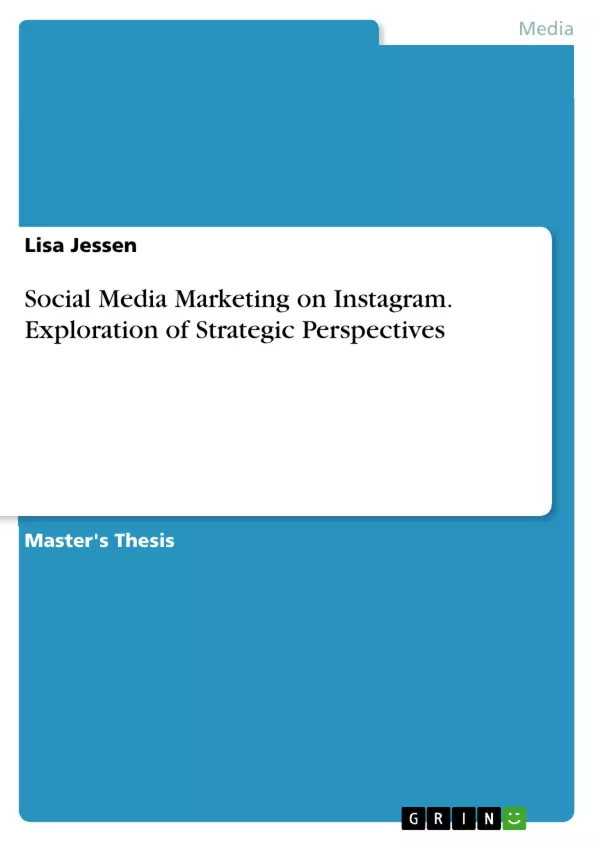With 800 million users worldwide Instagram is one of the world’s leading social media platforms. The reason for the increasing relevance of Instagram is its mobile, local, social and visual character, which reflects how individuals are currently using social media and will continue to do so in the future. Instagram's combination of emotional visual content, story-telling and interaction with the community also makes it a platform that allows brands to differentiate themselves from others - to become unique in what are often very saturated markets.
While Instagram is a new application and previous research focuses mainly on long established social media platforms such as Facebook, this thesis aims to explore the various strategic perspectives of successful social media marketing on Instagram by developing a theoretical frame work and presenting the practical strategies of three very different organisations in a multiple-case study design.
The framework and the case studies prove that the five identified social media dimensions - content marketing, engagement marketing, influencer marketing, hashtags and Instagram advertising - are applied in practice but are adapted very individual on each organisation, its goals and its target group.
Inhaltsverzeichnis (Table of Contents)
- 1. INTRODUCTION AND STRUCTURE OF THE THESIS.
- 2. FOUNDATIONS OF SOCIAL MEDIA MARKETING ON INSTAGRAM.
- 2.1 Definitions and characteristics of Instagram as a marketing tool.
- 2.2 Analysis and goal setting for a successful Instagram account...
- 3. Dimensions of social Media marketing on instagram
- 3.1 Content Marketing.
- 3.2 Engagement marketing
- 3.3 Influencer Marketing
- 3.4 Hashtags......
- 3.5 Instagram Advertising.
- 4. CASE STUDIES.
- 4.1 Research Design...........
- 4.2 Case Study: Sabro GmbH.
- 4.3 Case Study: Kosmetik4less GmbH & Co. KG.
- 4.4 Case Study: PETA Deutschland e. V...
- 4.5 Comparison of the Case Studies
- 5. CONCLUSION.
- REFERENCES
- Case Study Interviews....
- Interview Sabro GmbH......
- Interview Kosmetik4less GmbH & Co. KG
- Interview PETA Deutschland e.V..
Zielsetzung und Themenschwerpunkte (Objectives and Key Themes)
This master thesis investigates the strategic aspects of successful social media marketing on Instagram. It aims to develop a theoretical framework by analyzing the unique characteristics of Instagram and applying it to real-world examples through a multiple-case study design. The thesis also aims to demonstrate how different organisations can adapt the five key social media dimensions - content marketing, engagement marketing, influencer marketing, hashtags, and Instagram advertising - to their specific goals and target audiences.
- Defining and analyzing the unique features of Instagram as a marketing tool.
- Developing a theoretical framework for effective social media marketing on Instagram.
- Examining the application of key social media dimensions in practical scenarios.
- Conducting case studies to analyze the strategies of three different organisations.
- Comparing and contrasting the case studies to illustrate the adaptability of the framework.
Zusammenfassung der Kapitel (Chapter Summaries)
The first chapter introduces the thesis and outlines its structure. It highlights the growing importance of Instagram for social media marketing, emphasizing the platform's unique mobile, local, visual, and social characteristics. The second chapter delves into the foundations of social media marketing on Instagram, providing definitions for key terms like social media and social media marketing. This chapter also explores the benefits of Instagram in comparison to other platforms like Twitter and Facebook, emphasizing the crucial role of target group analysis and goal setting for successful Instagram marketing. The third chapter focuses on the five key dimensions of social media marketing on Instagram: content marketing, engagement marketing, influencer marketing, hashtags, and Instagram advertising. This section provides a theoretical framework for understanding and applying these dimensions within a strategic context.
Schlüsselwörter (Keywords)
The core concepts and terms explored in this thesis include social networking sites (SNS), Instagram, social media marketing, social media strategy, multiple case study, content marketing, engagement marketing, influencer marketing, hashtags, and Instagram advertising. These keywords encapsulate the primary research focus, key themes, and practical applications discussed throughout the work.
- Arbeit zitieren
- Lisa Jessen (Autor:in), 2018, Social Media Marketing on Instagram. Exploration of Strategic Perspectives, München, GRIN Verlag, https://www.grin.com/document/427706



